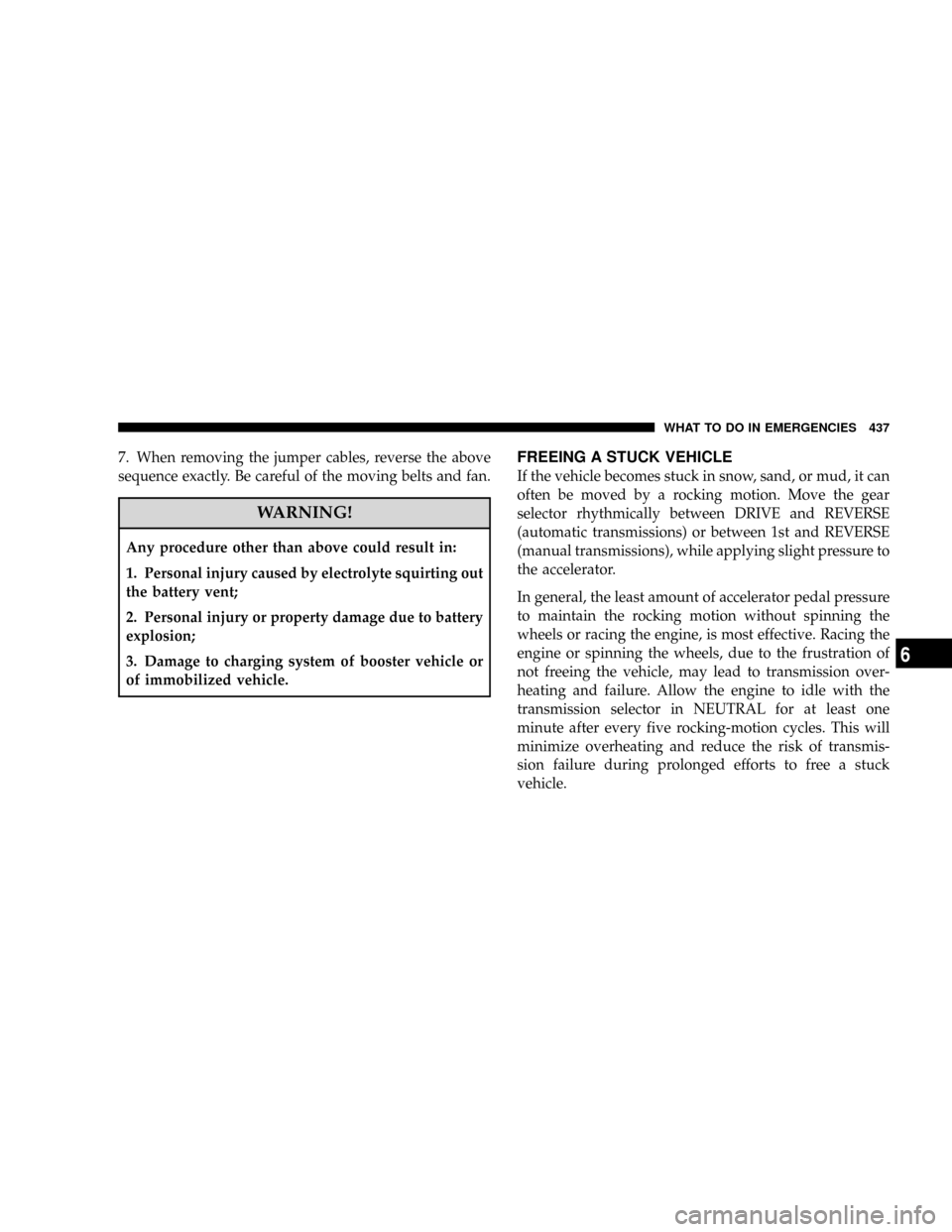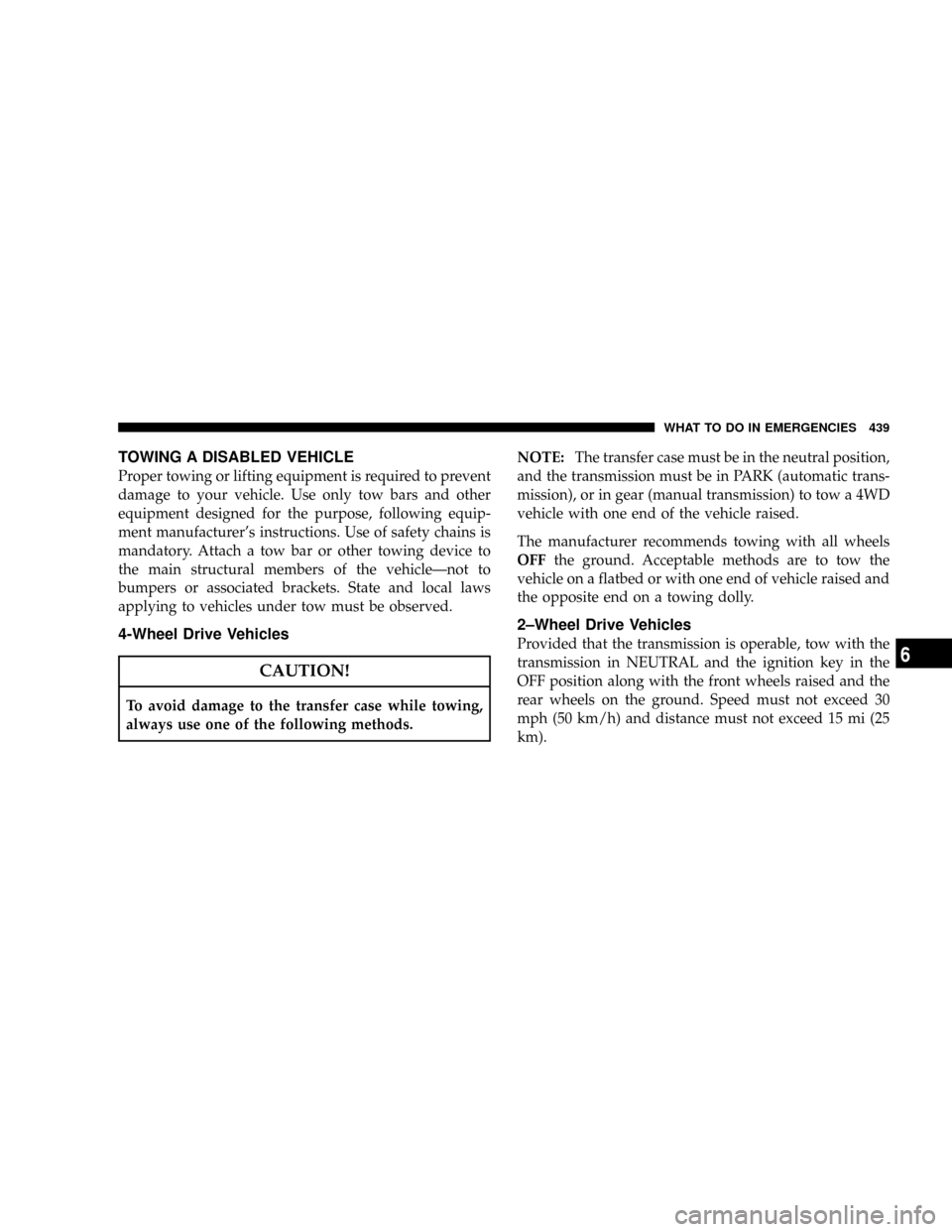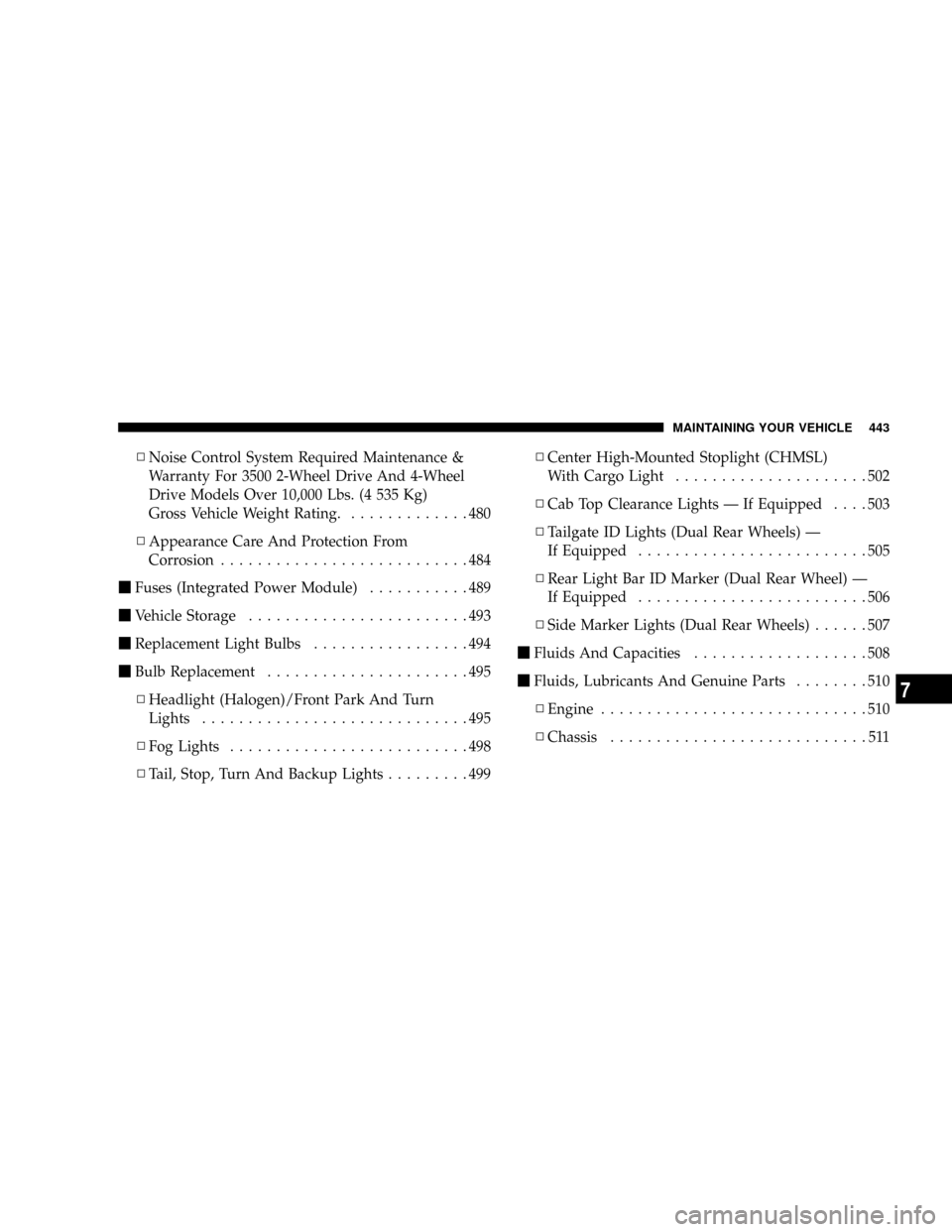Page 439 of 554

7. When removing the jumper cables, reverse the above
sequence exactly. Be careful of the moving belts and fan.
WARNING!
Any procedure other than above could result in:
1. Personal injury caused by electrolyte squirting out
the battery vent;
2. Personal injury or property damage due to battery
explosion;
3. Damage to charging system of booster vehicle or
of immobilized vehicle.
FREEING A STUCK VEHICLE
If the vehicle becomes stuck in snow, sand, or mud, it can
often be moved by a rocking motion. Move the gear
selector rhythmically between DRIVE and REVERSE
(automatic transmissions) or between 1st and REVERSE
(manual transmissions), while applying slight pressure to
the accelerator.
In general, the least amount of accelerator pedal pressure
to maintain the rocking motion without spinning the
wheels or racing the engine, is most effective. Racing the
engine or spinning the wheels, due to the frustration of
not freeing the vehicle, may lead to transmission over-
heating and failure. Allow the engine to idle with the
transmission selector in NEUTRAL for at least one
minute after every five rocking-motion cycles. This will
minimize overheating and reduce the risk of transmis-
sion failure during prolonged efforts to free a stuck
vehicle.
WHAT TO DO IN EMERGENCIES 437
6
Page 441 of 554

TOWING A DISABLED VEHICLE
Proper towing or lifting equipment is required to prevent
damage to your vehicle. Use only tow bars and other
equipment designed for the purpose, following equip-
ment manufacturer's instructions. Use of safety chains is
mandatory. Attach a tow bar or other towing device to
the main structural members of the vehicleÐnot to
bumpers or associated brackets. State and local laws
applying to vehicles under tow must be observed.
4-Wheel Drive Vehicles
CAUTION!
To avoid damage to the transfer case while towing,
always use one of the following methods.NOTE:The transfer case must be in the neutral position,
and the transmission must be in PARK (automatic trans-
mission), or in gear (manual transmission) to tow a 4WD
vehicle with one end of the vehicle raised.
The manufacturer recommends towing with all wheels
OFFthe ground. Acceptable methods are to tow the
vehicle on a flatbed or with one end of vehicle raised and
the opposite end on a towing dolly.
2±Wheel Drive Vehicles
Provided that the transmission is operable, tow with the
transmission in NEUTRAL and the ignition key in the
OFF position along with the front wheels raised and the
rear wheels on the ground. Speed must not exceed 30
mph (50 km/h) and distance must not exceed 15 mi (25
km).
WHAT TO DO IN EMERGENCIES 439
6
Page 442 of 554
CAUTION!
Towing faster than 30 mph (50 km/h) or for more than
15 mi (25 km) can cause severe damage to the
transmission.If the vehicle is to be towed faster than 30 mph (50 km/h)
or more than 15 mi (25 km) the vehicle must be towed
with the rear wheels raised and the front wheels on the
ground. It may also be towed on a flatbed or with the
front wheels raised and the rear wheels on a dolly.
440 WHAT TO DO IN EMERGENCIES
Page 444 of 554

NMaintenance-Free Battery................457
NAir Conditioner Maintenance.............459
NPower Steering Ð Fluid Check............460
NFront Suspension Ball Joints..............460
NSteering Linkage Ð Inspection............461
NHalf-Shaft Constant Velocity Joints.........461
NFront Prop Shaft Lubrication Ð
2500/3500 (4X4) Models................462
NBody Lubrication.....................462
NWindshield Wiper Blades................463
NWindshield Washers...................463
NExhaust System......................464NCooling System.......................465
NHoses And Vacuum/Vapor Harnesses.......470
NFuel System Connections................471
NBrake System........................471
NClutch Hydraulic System................474
NClutch Linkage.......................474
NRear Axle And 4X4 Front Driving Axle
Fluid Level..........................474
NTransfer Case........................475
NManual Transmission..................476
NAutomatic Transmission................476
NFront And Rear Wheel Bearings...........479
442 MAINTAINING YOUR VEHICLE
Page 445 of 554

NNoise Control System Required Maintenance &
Warranty For 3500 2-Wheel Drive And 4-Wheel
Drive Models Over 10,000 Lbs. (4 535 Kg)
Gross Vehicle Weight Rating..............480
NAppearance Care And Protection From
Corrosion...........................484
mFuses (Integrated Power Module)...........489
mVehicle Storage........................493
mReplacement Light Bulbs.................494
mBulb Replacement......................495
NHeadlight (Halogen)/Front Park And Turn
Lights.............................495
NFog Lights..........................498
NTail, Stop, Turn And Backup Lights.........499NCenter High-Mounted Stoplight (CHMSL)
With Cargo Light.....................502
NCab Top Clearance Lights Ð If Equipped....503
NTailgate ID Lights (Dual Rear Wheels) Ð
If Equipped.........................505
NRear Light Bar ID Marker (Dual Rear Wheel) Ð
If Equipped.........................506
NSide Marker Lights (Dual Rear Wheels)......507
mFluids And Capacities...................508
mFluids, Lubricants And Genuine Parts........510
NEngine.............................510
NChassis............................511
MAINTAINING YOUR VEHICLE 443
7
Page 463 of 554

The ball joints originally supplied with the vehicle are
permanently lubricated at the factory and do not require
service. However, if the seals on the ball joints are
damaged, the joints should be replaced. Serviceable
replacement ball joints are available.
Front suspension ball joints should be replaced only by a
qualified service technician using tools specially de-
signed for this purpose. Damage to the joints and/or
suspension components may result if improper replace-
ment procedures are used.
If seals are damaged the ball joints should be replaced to
prevent leakage or contamination of the grease.
Steering Linkage Ð Inspection
Whenever the vehicle is hoisted, all steering linkage
joints should be inspected for evidence of damage. If
seals are damaged, parts should be replaced to preventleakage or contamination of the grease. Lubricate the
steering linkage regularly according to the ªMaintenance
Scheduleº in this manual.
Half-shaft Constant Velocity Joints
All four-wheel drive 1500 models are equipped with four
constant velocity joints. Periodic lubrication of these
joints is not required. However, the joint boots should be
inspected for external leakage or damage, periodically. If
external leakage or damage is evident, the joint boot and
grease should be replaced immediately. Continued op-
eration could result in failure of the joint due to water
and dirt contamination of the grease. This would require
complete replacement of the joint assembly. Refer to the
Service Manual for the detailed replacement procedure.
MAINTAINING YOUR VEHICLE 461
7
Page 481 of 554

7. Check for leaks. Release parking brake.
To prevent dirt and water from entering the transmission
after checking or replenishing fluid, make certain that the
dipstick cap is properly reseated. It is normal for the
dipstick cap to spring back slightly from its fully seated
position, as long as its seal remains engaged in the
dipstick tube.
Automatic Transmission Fluid and Filter Change
Follow the Maintenance Schedule for recommended
transmission fluid and filter change intervals.
NOTE:If the transmission is disassembled for any
reason, the fluid and filter(s) should be changed.
It is important that proper lubricant is used in the
transmission. For the correct Fluid type, refer to ªFluids,
Lubricants and Genuine Partsº in this Section.
Special Additives
Automatic Transmission Fluid (ATF) is an engineered
product and its performance may be impaired by supple-
mental additives. Therefore, do not add any fluid addi-
tives to the transmission. The only exception to this
policy is the use of special dyes to aid in detecting fluid
leaks. In addition, avoid using transmission sealers as
they may adversely affect seals.
Front and Rear Wheel Bearings
Front Wheel Bearings
Front wheel bearings for all vehicles are sealed-for-life.
They do not require greasing or seal replacement. In
some instances, these bearings will ªpurgeº excess grease
and the bearing will look slightly wet. This is normal.
Periodic inspection for excess play is recommended.
MAINTAINING YOUR VEHICLE 479
7
Page 482 of 554
Rear Wheel Bearings Ð Manufacturer's Axles
These bearings are normally considered permanently
lubricated. Cleaning and repacking is required only
when axle shafts are removed or in case of extreme water
or dust contamination.
Noise Control System Required Maintenance &
Warranty For 3500 2-Wheel Drive and 4-Wheel
Drive models over 10,000 lbs. (4 535 kg) Gross
Vehicle Weight Rating.
All vehicles built over 10,000 lbs (4 535 kg) Gross Vehicle
Weight Rating and manufactured for sale and use in the
United States are required to comply with the Federal
Government's Exterior Noise Regulations. These vehiclescan be identified by the Noise Emission Control Label
located in the operator's compartment.
480 MAINTAINING YOUR VEHICLE